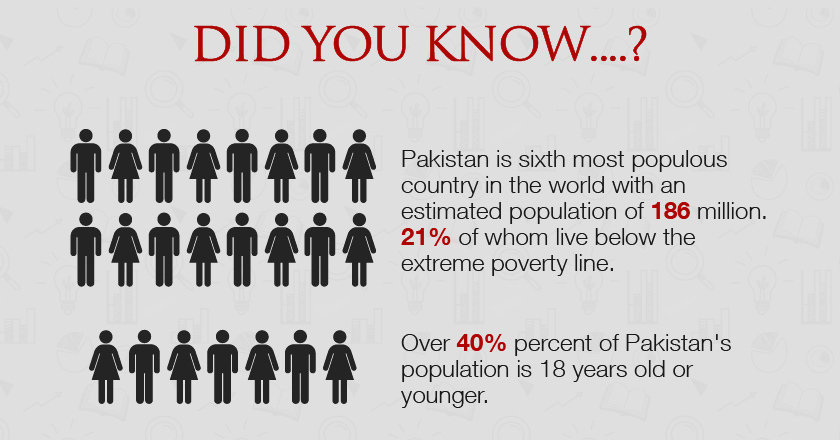Pakistan is a huge country with a population of nearly 200 million. No government alone can meet the healthcare, education and social welfare requirements of its people of which 21% live below the extreme poverty line on less than US $1.25/day. Under these circumstances, involvement of non-state actors seems quite important. Unfortunately non-state actors such as NGOs are sometimes viewed with suspicion and sometimes thought of as minting money from donor agencies and utilizing it to serve foreign agendas as well as their own vested interests.
A responsible government always strives to come up with the expectations of its people but it is not possible for any government to cater to the needs of its citizen every time. In order to ensure good governance, governments try to increase participation by both men and women either direct or through legitimate intermediate institutions or representatives. Such an involvement by the people may give rise to non-profit organizations also known as Non-governmental organization (NGO) to be an actor in governance.
In Pakistan, a majority of NGOs are offering their services in healthcare, education and human rights sectors and are doing well. What they lack is proper image building and taking three key elements i.e. Beneficiaries (existing and potential), Donors (existing and potential), Volunteers (existing and potential) on board through effective communication efforts. At present, more than 150,000 NGOs have been registered in Pakistan out of which 45,000 are active and operational. These vary from international NGOs to community-based organizations in the rural areas of Pakistan. There are 41 international NGOs in Pakistan, including 11 UN affiliated organizations.
MARKETING AND BRANDING NGO’S
NGOs are also brands and therefore need to focus on building their brands in order to market their vision, credibility, value, and impact of their work. In marketing their brand, they should also be accountable to their donors and other relevant stakeholders. In addition, they should develop a culture of transforming their monitoring and evaluating their data into case studies and other materials that could be of interest to the donor market. These materials will also help them to build credibility for their causes. Lastly, they should develop interactive websites to enable their staff to interact with donors/potential donors, volunteers and other interested stakeholders.
Javed Jabbar, Chairman and Chief Executive , JJ Media ( PVT) ltd, gives an insight into the importance of NGO’s in our society in the video below: Javed Jabbar is also a writer, film maker, policy analyst, former senator and federal minister.
The following are key dos and don’ts that will help to market and brand an NGO effectively:
Define your message
Define who you are, and what it is that you do (a support organisation, community-based or policy and lobbying organisation?) and establish your core values, the honesty and ethics that shape you.
Message positively
Today’s message is wholly positive – it’s about engaging with people, convincing them of your mission and bringing them on board.
Feedback
It’s simple psychology, but people give to feel good. So always say thank you, and involve them in your work. People enjoy their association to better the world around them, and want to feel a part of the action. As your donor base gets bigger, newsletters become essential but should never replace personalised communication.
Thank you, In-Kindly
NGOs and charities are fixated with money, but these aren’t the only forms of giving. Some of the best value donations are in-kind, from training, corporate services and skills transfer to volunteer programmes – and there are clear links between legacy pledges and involvement. Expand your task.
Think like a donor
Potential investors are likely to encounter your brand before they encounter you. What is the message you want them to take home? Your marketing must entrench the vision of the organisation, and engage with your target audience. Use your impact – you’re selling your work, not a product, so make it personable. Transform your monitoring and evaluation data into case studies and market your impact.
New Media
The Internet is a wonderful environment to inform people of what you do, raise awareness on campaigns, and have a donations/volunteer page. Spend money building a decent, professional website and take the time to update it regularly and invite and respond to feedback. Invest in a search engine optimisation tool, use Google Ads, and set up pages on Twitter, Youtube and Facebook. There are myriad ways to keep your world in the mind of others online, and communicate what is being done.
Combine new and old technologies – charities such as Shelter in the UK are using print media such as posters and flyers to capture interest, and are following up with SMS’s once people are on board.
Surveys
Surveys are underutilised in our country, but make for great copy in the media. They don’t always have to be serious news – if they are, great, you’ve bagged a genuine news headline that outlines the merits of your cause.
Market your charity’s IMPACT
All good charities will have intensive monitoring and evaluation studies of their projects. Instead of regarding this as data, transform it into case studies, stories, photo-essays and information that can be fed back into the donor market and build credibility for your cause.
Get Media Savvy
Don’t just target the newsdesk – target all sections of the newspaper from features, travel and business through to recruitment. Build relationships with journalists at different papers, know what they need and target them appropriately. Be available – make sure that you have people on call and can respond to queries at all hours. Don’t become institutionalised and bland in your messages with stock phrases or the infuriating No Comment. Don’t forget your local press. Spend time on the intro of your press releases and make sure you engage the reader. The golden rule is to e-mail press releases, but phone through exclusives.
Finally…
Measure the impact of your marketing
Do people now recognise your charity? Do they associate your brand with your values? Have you increased your funds? Have you improved your lobbying position and the pressure you place on government? Do people view you as a credible respected organisation? It is essential to measure the response to your marketing, to ensure that your message is broadcasting successfully, to allow you to adjust and change your strategy if it’s not, and to enable you to report back to your donors – reinforcing your core values as a credible, ethical and accountable organisation.







































